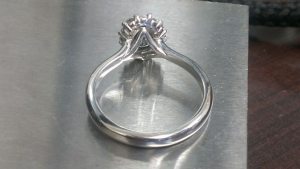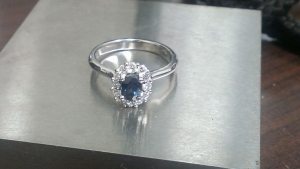
Rebuilding After Disaster: Lewis Jewelers
Our Experience
Lewis Jewelers was in business for over thirty years before one spring day in 2013 changed everything. A tornado touched down outside Oklahoma City, taking the manufacturing arm of the Lewis’s small jewelry business with it.
Brothers Glenn and Tim Lewis lost approximately 30,000 master molds and castings when their workshop was destroyed in the EF5 level disaster. The tornado also wrecked an essential machining instrument for finishing casts. Though the damage was significant, the brothers were grateful that they and their families were safe amid the destruction that flattened buildings and took lives — “You start to see it’s just stuff,” said Glenn Lewis, who is also the Mayor of Moore. In that frame of mind, the company began to rebuild.
Before the tornado, Lewis Jewelry was employing small-scale 3D printing during production, but the machinery — an Asiga model — didn’t produce satisfactory results due to the size of the build plate and the casting material. “We knew there had to be something better,” said Glenn. Both brothers were apprenticed in traditional jewelry-making methods before later becoming interested in next-level processes like CAD/CAM. Before experimenting with rapid prototyping, Tim carved wax to create models, and he continued to do so even with the Asiga; the machine produced a small number of pieces at a time, which then tended to cast with difficulty. According to the Lewises’ CAD designer Roger Kitchens the Asiga material requires high-temperature investment to cast, which needs a hammer to break open. The EnvisionTEC models can be cast using standard gypsum investment, which can be easily removed in water.
“We needed this machine.”
Since wax carving is a lengthy process, the brothers frequently bought rubber molds from other companies, sacrificing original design in order to run their business.
The lower-grade Asiga machine “just wasn’t what we needed,” revealed Glenn, “especially since we lost our molds.” Glenn and Tim decided to invest in the best 3D printer they could find. “We needed a new way to process [our pieces] and we wanted to upgrade to a modern way of producing these models.” It took forty years to collect the rubber molds, so Lewis Jewelers needed a solution that was accelerated during production time in order to begin restoring their lost designs.
The Lewis brothers attended a 3D printing course in Los Angeles but were unimpressed with the selection of machines the program demonstrated. The Lewises decided they wanted a product that they could feasibly run themselves without monthly service or technician fees. When they made the decision to invest in EnvisionTEC, they chose the Perfactory® Aureus as the best of the series for their jewelry manufacturing outfit, upon EnvisionTEC’s recommendation.
Glenn Lewis believes additive manufacturing is the future, for his business as well as for the jewelry-making industry in general. He and his brother purchased the Perfactory® Aureus from EnvisionTEC in October 2013. They wanted to upgrade their production, but they also needed to replace forty years’ worth of master castings. In barely a month since its investment, Lewis Jewelers has seen profits rise by nearly a third. Glenn Lewis credits the EnvisionTEC machine for this transformation.
“The design process has changed 180 degrees.”
Lewis Jewelers uses the Perfactory® printer in-house at their store six days a week. With the help of CAD-specialized technician Roger Kitchens, the store produces up to twenty pieces a day “fairly [easily],” said Glenn. Not only is it important to the Lewises to be able to complete custom orders quickly, it’s also key that their store has an impressive inventory ready for customers to see and touch. About five rings a day are custom engagement ring orders, while the rest are inventory pieces. At the time of the interview, the store took six custom ring orders in the morning. The ability to complete the entire project in-house is what instills customer faith in the business. “They would have gone elsewhere,” Glenn said.
For Lewis Jewelry, the aim is to integrate design, production and sales. The Perfactory® Aureus allows the business to provide a definitive experience: customers can come into the store and try on a wide variety of pieces — rather than simply viewing them on a computer screen — before making their selection.
“We actually build the pieces and put them in the showcases because [we] have the [gemstone] stone inventory to do that. We want people to try it on and not just look at it,” said Glenn.
The inclusion of the colored stone inventory is perhaps atypical for most jewelry stores, but it demonstrates how the Perfactory® systems can be an asset to any outfit. In part, the process of bolstering inventory will regenerate some of the collection the company lost in the tornado. Using the Perfactory® machine, Glenn and Tim have grown their business by a significant margin, and the increase continues each month. Glenn claims Lewis Jewelers’ profits are up on the year even after weathering the tornado (and losing a month of production in the aftermath). Lewis Jewelers currently has 2,500 engagement rings in stock.
“Our goal is to eventually get to 5,000 [engagement rings]… And to become the largest engagement ring [manufacturer] in the state… As we continue that, and more and more people tell each other about our product, then that’s more people that come into the store, and of course that means people buy.”
The Lewis’ hope to purchase a second Perfactory® system as long as demand continues to increase. In the meantime, the single Aureus currently at the store in Moore continues to draw clients who want to see the printer in action and experience the finished products.





